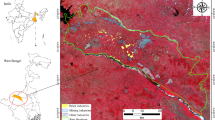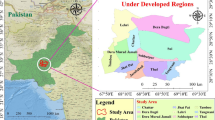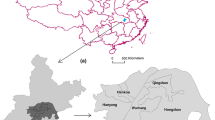Abstract
The fall of the communist regime in Romania at the end of 1989 and the ensuing transition to the market economy brought about many changes in the use of agricultural land. These changes combined with the action of climatic factors led, in most cases, to negative effects increasing the risk of degradation of agricultural land. This study aims to assess and monitor the risk of land degradation in Baragan Plain, Romania, for the period 1988–2011 using Landsat Thematic Mapper (TM) and Spectral Mixture Analysis (SMA). Each satellite image was classified through the Decision Tree Classifier (DTC) method; then, on the basis of certain threshold values, we obtained maps of land degradation and maps showing the passage from various classes of land use/land cover (LULC) to land degradation. The results indicate that during the intermediary periods there was an ascending and descending trend in the risk of land degradation determined by the interaction of climatic factors with the social-economic ones. For the entire period, the overall trend was ascending, the risk of land degradation increasing by around 4.60 % of the studied surface. Out of the climatic factors, high temperatures and, implicitly, drought were the most significant. The social-economic factors are the result of the changes which occurred after the fall of the communist regime, the most important being the fragmentation of agricultural land and the destruction of the irrigation system.










Similar content being viewed by others
References
Adams, J. B., Sabol, D. E., Kapos, V., Filho, R. A., Roberts, D. A., Smith, M. O., et al. (1995). Classification of multispectral images based on fractions of endmembers: application to land cover change in the Brazilian Amazon. Remote Sensing of Environment, 52(2), 137–154.
Al Dousari, A. M., Misak, R., & Shahid, S. (2000). Soil compaction and sealing in AL-Salmi area, western Kuwait. Land Degradation and Development, 11(5), 401–418.
Antofie, T., Naumann, G., Spinoni, J., & Vogt, J. (2015). Estimating the water needed to end the drought or reduce the drought severity in the Carpathian region. Hydrology and Earth System Sciences, 19(1), 177–193.
Bălteanu, D., Popescu, M., & Urşanu, E. A. (2004). Land tenure and land relations in Romania. In V. Belenkiy (Ed.), International encyclopedia of land tenure and land relations in the world (pp. 357–453). New York: Edwin Mellen Press.
Barrow, C. J. (1991). Land degradation: development and breakdown of terrestrial environments. Cambridge: Cambridge University Press.
Borşan, T., & Voicu, G. E. (2009). Geographic Information Systems. Alba Iulia: “1 Decembrie 1918” University (in Romanian).
Brandt, J. S., & Townsend, P. A. (2006). Land use–land cover conversion, regeneration and degradation in the high elevation Bolivian Andes. Landscape Ecology, 21(4), 607–623.
Chehbouni, A., Goodrich, D., Moran, M., Watts, C., Kerr, Y., Dedieu, G., et al. (2000). A preliminary synthesis of major scientific results during the SALSA program. Agricultural and Forest Meteorology, 105(1–3), 311–323.
Gao, J., & Liu, Y. (2010). Determination of land degradation causes in Tongyu County, Northeast China via land cover change detection. International Journal of Applied Earth Observation and Geoinformation, 12(1), 9–16.
Greşiţă, C. I. (2011). Expert system used for monitoring the behavior of hydrotechnical constructions. REVCAD-Journal of Geodesy and Cadastre, 11, 75–84.
Greşiţă, C. I. (2013). Surveying methods to studying the behavior of dams. Iaşi: Tehnopress Publishing House (in Romanian).
IGAR (2014). Report on climate change effects for Baragan Plain. Romania.
Iordache, E. (2010). Accessibility of forests. Brasov: Transilvania University Publishing House (in Romanian).
Ienciu, I., Dimen, L., Ludusan, N., Grecea, C., Borşan, T., & Oprea, L. (2012). Dynamics of the rill and gully erosion using GIS technologies. Journal of Environmental Protection and Ecology, 13(1), 345–351.
Jensen, J. R. (1996). Introductory digital image processing: a remote sensing. perspective (2nd ed.). New Jersey: Prentice-Hall, Upper Saddle River.
Johnson, D. L., & Lewis, L. A. (1995). Land degradation: creation and destruction. Oxford: Blackwell Publishers.
Kaplan, S., Blumberg, D. G., Mamedov, E., & Orlovsky, L. (2014). Land-use change and land degradation in Turkmenistan in the post-Soviet era. Journal of Arid Environments, 103, 96–106.
Lu, D., Mausel, P., Brondizio, E., & Moran, E. (2002). Assessment of atmospheric correction methods for Landsat TM data applicable to Amazon basin LBA research. International Journal of Remote Sensing, 23(13), 2651–2671.
Lu, D., & Weng, Q. (2004). Spectral mixture analysis of the urban landscape in Indianapolis with Landsat ETM+ imagery. Photogrammetric Engineering and Remote Sensing, 70(9), 1053–1062.
Lu, D., Batistella, M., Mausel, P., & Moran, E. (2007). Mapping and monitoring land degradation risks in the Western Brazilian Amazon using multitemporal Landsat TM/ETM+ images. Land Degradation and Development, 18(1), 41–54.
Marcu, V., Bîlea, C., Gheorghiţă, G., & Dolocan, C. (2011). Particular aspects of the rainfall regime in Vlasiei Plains. Bulletin of the Transilvania University of Braşov Series II: Forestry, Wood Industry, Agricultural Food. Engineering, 4(53, 2), 53–58.
Marcu, M., & Marcu, V. (2012). Forest meteorology and climatology. Brasov: Transilvania University Publishing House (in Romanian).
Munteanu, C., Niţă, M. D., Abrudan, I. V., & Radeloff, V. C. (2016). Historical forest management in Romania is imposing strong legacies on contemporary forests and their management. Forest Ecology and Management, 361, 179–193.
National Institute of Statistics (2006). Farm structure survey 2005. Bucharest.
National Institute of Statistics (2010a). General agricultural census 2010. Bucharest.
National Institute of Statistics (2010b). Romanian statistical yearbooks 1990–2010. Bucharest.
National Institute of Statistics (2015). TEMPO-Online database. http://statistici.insse.ro/shop/?page = termeni&lang = en. Accessed 20 June 2015.
Oldeman, R. L., Hakkeling, R. T. A., & Sombroek, W. G. (1990). World map of the status of human-induced soil degradation. An explanatory note. Wageningen, Netherlands: International Soil Reference and Information Centre.
Pech, R. P., Davis, A. W., Lamacraft, R. R., & Graetz, R. D. (1986). Calibration of LANDSAT data for sparsely vegetated semi-arid rangelands. International Journal of Remote Sensing, 7(12), 1729–1750.
Roberts, D. A., Batista, G. T., Pereira, J. L. G., Waller, E. K., & Nelson, B. W. (1998). Change identification using multitemporal spectral mixture analysis: applications in eastern Amazonia. In R. S. Lunetta & C. D. Elvidge (Eds.), Remote sensing change detection: environmental monitoring applications and methods (pp. 137–161). Chelsea: Ann Arbor Press.
Sevastel, M., Petrescu, N., Musat, M., Radu, A., & Sarbu, N. (2010). Soil erosion and conservation in Romania—some figures, facts and its impact on environment. Annals. Food Science and Technology, 11(1), 105–110.
Shoshany, M., Golik, A., Degani, A., Lavee, H., & Gvirtzman, G. (1996). New evidence for sand transport direction along the coastline of Israel. Journal of Coastal Research, 12(1), 311–325.
Sima, M., Popovici, E. A., Bălteanu, D., Micu, D. M., Kucsicsa, G., Dragotă, et al. (2015). A farmer-based analysis of climate change adaptation options of agriculture in the Baragan Plain Romania. Earth. Perspectives, 2(1), 1–21.
Small, C. (2001). Estimation of urban vegetation abundance by spectral mixture analysis. International Journal of Remote Sensing, 22(7), 1305–1334.
Small, C. (2002). Multitemporal analysis of urban reflectance. Remote Sensing of Environment, 81(2–3), 427–442.
Smith, M. O., Ustin, S. L., Adams, J. B., & Gillespie, A. R. (1990). Vegetation in deserts: I. A regional measure of abundance from multispectral images. Remote Sensing of Environment, 31(1), 1–26.
Tereşneu, C. C. (2012). Automatic data processing of geodetic data. Brasov: Transilvania University Publishing House (in Romanian).
Turubanova, S., Potapov, P., Krylov, A., Tyukavina, A., McCarty, J. L., Radeloff, V. C., et al. (2015). Using the Landsat data archive to assess long-term regional forest dynamics assessment in Eastern Europe, 1985–2012. International Archives of the Photogrammetry. Remote Sensing and Spatial Information Sciences, XL-7(W3), 531–537.
Vorovencii, I. (2015). Assessing and monitoring the risk of desertification in Dobrogea, Romania, using Landsat data and decision tree classifier. Environmental Monitoring and Assessment, 187(4), Article 204.
Vrînceanu, G. A. (2011). Research on the vulnerability of soils to the degradation processes—desertification in the Baragan Plain. PhD Thesis, University of Agronomic Sciences and Veterinary Medicine: Bucharest, 256 p.
Wu, C., & Murray, A. (2003). Estimating impervious surface distribution by spectral mixture analysis. Remote Sensing of Environment, 84(4), 493–505.
Acknowledgments
The author thanks the United States Geological Survey (USGS) for providing the Landsat TM satellite images, and lecturer Raluca Sinu for her support with the English language. Also, the author would like to thank the two anonymous reviewers for their constructive observations and comments.
Author information
Authors and Affiliations
Corresponding author
Rights and permissions
About this article
Cite this article
Vorovencii, I. Assessing and monitoring the risk of land degradation in Baragan Plain, Romania, using spectral mixture analysis and Landsat imagery. Environ Monit Assess 188, 439 (2016). https://doi.org/10.1007/s10661-016-5446-5
Received:
Accepted:
Published:
DOI: https://doi.org/10.1007/s10661-016-5446-5




